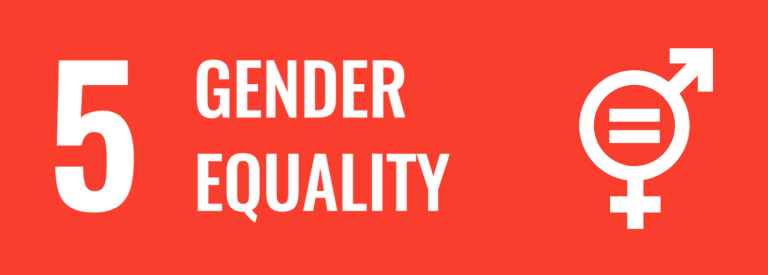Sustainable Development Goal 5 - Gender Equality

SDG 5: Achieve gender equality and empower all women and girls
Only when men and women work together, can they build weather and climate-resilient societies. WMO is committed to achieving gender equality and empowering girls and women. This is not just a matter of equity and justice. It is also essential to meeting the challenges of climate change, disaster risk reduction and sustainable development. Their talent, energy and skills must be fully unleashed to ensure rapid progress in science and operational services.
Priority areas
Women and men are affected differently by weather and climate. Gender sensitivities are particularly pronounced in the areas of disaster risk reduction, public health, water resources management, and agriculture and food security.
Disaster risk reduction
The impact of disasters is different on men and women due to social constructs. Every day, disasters related to weather, water, climate and environmental extremes – that is, stemming from storms, droughts, floods and extreme temperatures – impact lives, livelihoods and socio-economic development around the world. These impacts are exacerbated by climate variability and change.
In disaster situations, women may obtain relevant information differently, and have distinct needs and differing access to resources that aid recovery due to gender-based divisions of labour, patterns of mobility and socially-expected behaviour patterns.
Equal inclusion of women’s and men’s voices in disaster risk management activities is essential to reduce impacts and build community resilience. Providers of weather and climate services for disaster risk reduction must enhance design and delivery for women to have better access to critical information crucial to decision-making in such situations. The experiences, knowledge and expertise of women are vital resources for disaster response and community resilience, climate change adaptation and disaster risk reduction strategies and processes.
Agriculture and food security
Empowering women to use weather and climate services effectively in agriculture is essential to achieving a world without hunger. Some 842 million people worldwide cannot afford to eat adequately and are chronically hungry. Over 70% of them live in rural areas in developing countries. Many are smallholder subsistence producers and family farmers who may not always grow enough to meet their families’ needs. And many are women. The most recent figures show that about half of the women in the world are active in agriculture – 60% in developing countries and 70 % in low-income food-deficit countries. Figures also show that female farmers generally have less access to land, fertilizers and machinery as well as financial and extension services. Therefore, it is urgent to provide women with equitable access to weather and climate services to improve the productivity on their farms.
Weather and climate services can help address the livelihood crisis of farmers. Weather and climate services support more efficient use of the natural resources – soil, crop and climate – that are most important for agricultural productivity. However, many challenges still exist. National Meteorological and Hydrological Services (NMHS), particularly in developing countries, lack the technical capacity and competences needed to deliver timely and relevant weather and climate services that better meet the needs of the farming community. In addition, farmers in these countries – in particular the women – lack awareness of the availability of weather and climate services and would not know how to use them. A further challenge is posed by the fact that men and women also access and process such information in different ways and have different patterns of participation in training and decision-making.
Public health
Many of the health risks that are affected by weather and climate, such as under-nutrition and malaria, show gender differences in relation to vulnerability and impacts. These differences reflect the combined effects of physiological, behavioral and socially constructed influences. Gender differences are also found in vulnerability to the indirect and longer-term effects of weather and climate-related hazards. For example, droughts bring health hazards through reduced availability of water for drinking, cooking and hygiene, and through food insecurity. Both gender differences and gender inequalities can give rise to inequities between men and women in health status and access to health care. For example, a woman may not receive needed health care because norms in her community prevent her from travelling alone to a clinic.
The adverse health consequences resulting from gender inequalities can be changed. First, gender-sensitive research is needed to better understand the health implications of weather and climate impacts and associated policies. Second, capacity development on a large scale is required at two levels: targeted educational programmes and raising awareness among health professionals and the public. Finally, empowering women through education in science and technology will increase their awareness and create greater opportunities for their involvement in health issues.
Water resources management
From a gender perspective, the role of women in both accessing water and managing water resources needs to be addressed. Women are not a homogenous, vulnerable group, they are individuals who can be empowered to be part of planning and achieving a more sustainable future. Women are eager to participate in the honing of weather and climate services to answer to their need for accessible water supplies and to assist them in management of water resources.
Life is not possible without water and there is no substitute. We drink it, grow food with it, cook with it, bathe in it and use it for sanitation. We use it to create the goods and services that drive our global economy.
Big gender imbalances and inequities exist in the area of water and these will be exacerbated by climate variability and change. These imbalances – skewed toward men – hamper effective water provision, water policy formulation, water management, and climate change mitigation and adaptation.
How can we improve integrated water resources management, ensuring that all stakeholders in a basin or aquifer, especially women, take part? How can we promote the role of women in climate change adaptation at all levels: family, community, national and international?

